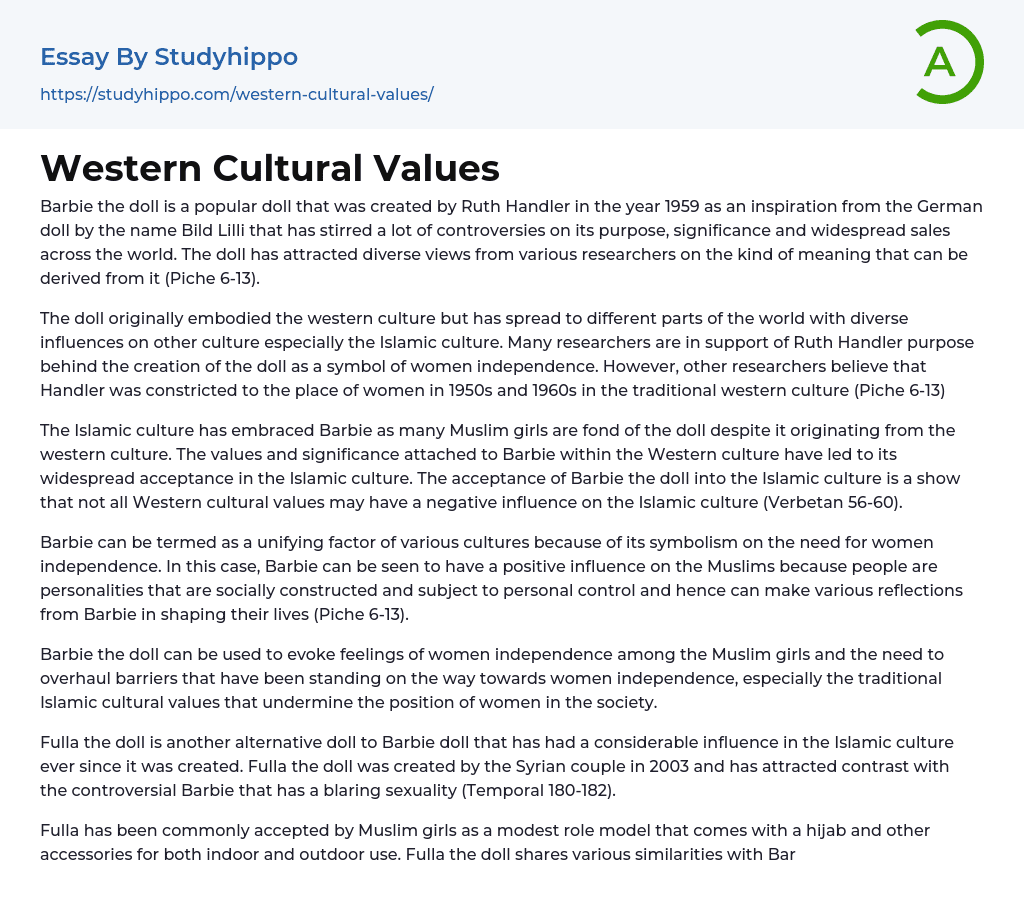Barbie the doll is a popular doll that was created by Ruth Handler in the year 1959 as an inspiration from the German doll by the name Bild Lilli that has stirred a lot of controversies on its purpose, significance and widespread sales across the world. The doll has attracted diverse views from various researchers on the kind of meaning that can be derived from it (Piche 6-13).
The doll originally embodied the western culture but has spread to different parts of the world with diverse influences on other culture especially the Islamic culture. Many researchers are in support of Ruth Handler purpose behind the creation of the doll as a symbol of women independence. However, other researchers believe that Handler was constricted to the place of women in 1950s and 1960s in the traditional western culture (Piche 6-13)
The Islami
...c culture has embraced Barbie as many Muslim girls are fond of the doll despite it originating from the western culture. The values and significance attached to Barbie within the Western culture have led to its widespread acceptance in the Islamic culture. The acceptance of Barbie the doll into the Islamic culture is a show that not all Western cultural values may have a negative influence on the Islamic culture (Verbetan 56-60).
Barbie can be termed as a unifying factor of various cultures because of its symbolism on the need for women independence. In this case, Barbie can be seen to have a positive influence on the Muslims because people are personalities that are socially constructed and subject to personal control and hence can make various reflections from Barbie in shaping their lives (Piche 6-13).
Barbie the doll can
be used to evoke feelings of women independence among the Muslim girls and the need to overhaul barriers that have been standing on the way towards women independence, especially the traditional Islamic cultural values that undermine the position of women in the society.
Fulla the doll is another alternative doll to Barbie doll that has had a considerable influence in the Islamic culture ever since it was created. Fulla the doll was created by the Syrian couple in 2003 and has attracted contrast with the controversial Barbie that has a blaring sexuality (Temporal 180-182).
Fulla has been commonly accepted by Muslim girls as a modest role model that comes with a hijab and other accessories for both indoor and outdoor use. Fulla the doll shares various similarities with Barbie and other Muslim dolls that mimic the western toys that spark new values in the Islamic culture.
Just like Barbie, Fulla has attracted several controversies surrounding its values and symbols that one can relate to it. Many people have questioned its authenticity and what values that can be linked with it despite it containing the Muslim concept of hijab. However, based on Fulla’s character put forth by the manufacturers, it’s a good idea to have it for those people who do not trust their personality and are weak in decision making. Fulla has been praised for its rich characters that symbolise the Muslim values and has been accepted in the Islamic culture (Alihodzic 36).
Fulla has been poised to stir reflection on the need to trust one's personality by adopting traits such as trust, love, respect, care, which the doll majorly portrays. The fact of Fulla being able to make
people relate to it on some things make people embrace it, as it portrays their personality and the need to trust the personality, especially under the Muslim construct. Moreover, Fulla helps people in making informed decisions based on the values that it evokes among people from its characters (Temporal 180-182).




